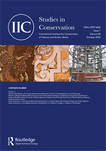 |
Helena P. Melo, Sara Valadas, António João Cruz, Ana Margarida Cardoso, Catarina Miguel, Ana Manhita, Yiğit Zafer Helvacı, Cristina Dias, António Candeias, "Italian influence in a Portuguese Mannerist painting (part I): a new palette with original orange and green pigments", Studies in Conservation, 68(7), 2023, pp. 731-746, doi:10.1080/00393630.2022.2133917 |
| Abstract |
The palette used by the Portuguese painter Pedro Nunes (1586-1637) in the large panel depicting The Descent from the Cross (460 x 304 cm) painted in 1620 for Évora's cathedral was investigated with a combination of the visual inspection of the paint surface and the analysis of the paint layers with microscopic, spectroscopic, and chromatographic techniques. Green earth and an orange artificial arsenic sulphide, two pigments identified for the first time in Portuguese paintings of the sixteenth and seventeenth centuries, were found to be abundantly used in large areas of the composition. The results further reveal the choice of a rich palette also containing lead-white, lead-tin yellow, ochre, vermilion, verdigris, smalt, azurite, vegetable carbon black, and a red lake made of brazilwood and cochineal. All the pigments were bound in an oil-based medium. The introduction of two pigments new to the Portuguese conventional palette is a direct consequence of the painter's training in Rome in the first decade of the seventeenth century. |
